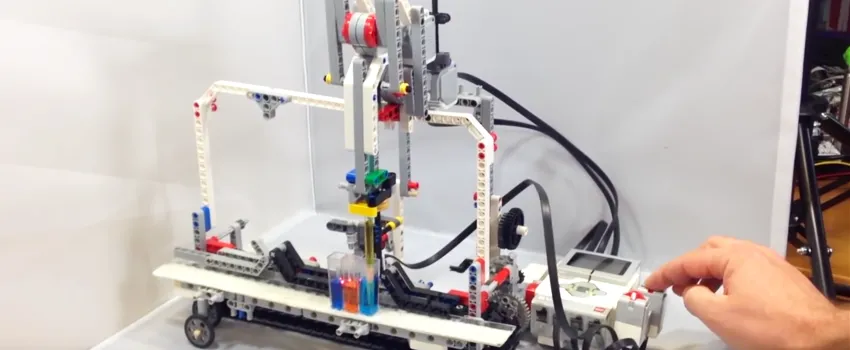
Screenshot from video by Stanford School of Engineering: Stanford researchers developed liquid-handling Lego robots for biology experiments in education and research.
Stanford News - March 21st, 2017 - by Andrew Myers
Elementary and secondary school students who later want to become scientists and engineers often get hands-on inspiration by using off-the-shelf kits to build and program robots. But so far it’s been difficult to create robotic projects to foster interest in the “wet” sciences – biology, chemistry and medicine – so called because experiments in these field often involve fluids.
Now, Stanford bioengineers have shown how an off-the shelf kit can be modified to create robotic systems capable of transferring precise amounts of fluids between flasks, test tubes and experimental dishes.
By combining the Lego Mindstorms robotics kit with a cheap and easy-to-find plastic syringe, the researchers created a set of liquid-handling robots that approach the performance of the far more costly automation systems found at universities and biotech labs.
“We really want kids to learn by doing,” said Ingmar Riedel-Kruse, assistant professor of bioengineering, who led the team that reports its work in the journal PLoS Biology.
“We show that with a few relatively inexpensive parts, a little training and some imagination, students can create their own liquid-handling robots and then run experiments on it – so they learn about engineering, coding and the wet sciences at the same time,” said Riedel-Kruse, who is also a member of Stanford Bio-X.
Robots meet biology
These robots are designed to pipette fluids from and into cuvettes and multiple-well plates –types of plastic containers commonly used in laboratories. Depending on the specific design, the robot can handle liquid volumes far smaller than one microliter, a droplet about the size of a single coarse grain of salt. Riedel-Kruse believes that these Lego designs might even be useful for specific professional or academic liquid-handling tasks where related robots cost many thousands of dollars.
His overarching idea is to enable students to learn the basics of robotics and the wet sciences in an integrated way. Students learn STEM skills like mechanical engineering, computer programming and collaboration while gaining a deeper appreciation of the value of robots in life sciences experiments.
Riedel-Kruse said he drew inspiration from the so-called constructionist learning theories, which advocate project-based discovery learning where students make tangible objects, connect different ideas and areas of knowledge and thereby construct mental models to understand the world around them. One of the leading theorists in the field was Seymour Papert, whose seminal 1980 book Mindstorms was the inspiration for the Lego Mindstorms sets.
“I saw how students and teachers were already using Lego robotics in and outside school, usually to build and program moving car-type robots, and I was excited by that – and the kids obviously as well,” he says. “But I saw a vacuum for bioengineers like me. I wanted to bring this kind of constructionist, hands-on learning with robots to the life sciences.”
Do it yourself
In their PLoS Biology paper, the team offers step-by-step building plans and several fundamental experiments targeted to elementary, middle and high school students. They also offer experiments that students can conduct using common household consumables like food coloring, yeast or sugar. In one experiment, colored liquids with distinct salt concentrations are layered atop one another to teach about liquid density. Other tests measure whether liquids are acids like vinegar or bases like baking soda, or which sugar concentration is best for yeast. Yet another experiment uses color-sensing light meters to align color-coded cuvettes.
The coding aspect of the robot is elementary, Riedel-Kruse said. A simple programming language allows students to place symbols telling the robot what to do: Start. Turn motor on. Do a loop. And so forth. The robots can be programmed and operated in different ways. In some experiments, students push buttons to actuate individual motors. In other experiments, students preprogram all motor actions to watch their experiments executed automatically.
“It’s kind of easy. Just define a few parameters and the system works,” he said, adding, “These robots can support a range of educational experiments and they provide a bridge between mechanical engineering, programming, life sciences and chemistry. They would be great as part of in-school and afterschool STEM programs.”
STEM-ready
Riedel-Kruse said these activities meet several important goals for promoting multidisciplinary STEM learning as outlined by the Next Generation Science Standards (NGSS) and other national initiatives. He stressed the cross-disciplinary instruction value that integrates robotics, biology, chemistry, programming and hands-on learning in a single project.
The team has co-developed these activities with summer high school students and a science teacher, and then tested them with elementary and middle school students over the course of several weeks of instruction. These robots are now ready for wider dissemination to an open-access community that can expand upon the plans, capabilities and experiments for this new breed of fluid-handling robots, and they might even be suitable to support certain research applications.
“We would love it if more students, do-it-yourself learners, STEM teachers and researchers would embrace this type of work, get excited and then develop additional open-source instructions and lesson plans for others to use,” Riedel-Kruse says.
See the PLoS Biology paper and Riedel-Kruse’s lab website for materials and instructions.
Lukas Gerber, a postdoctoral fellow in Riedel-Kruse’s lab, was first author on the paper. Other contributing authors include middle school science teacher Agnes Calasanz-Kaiser and three (at the time) high school students: Luke Hyman, Kate Voitiuk and Uday Patil. Funding was provided by grants from the National Science Foundation (Cyberlearning and National Robotics Initiative).
